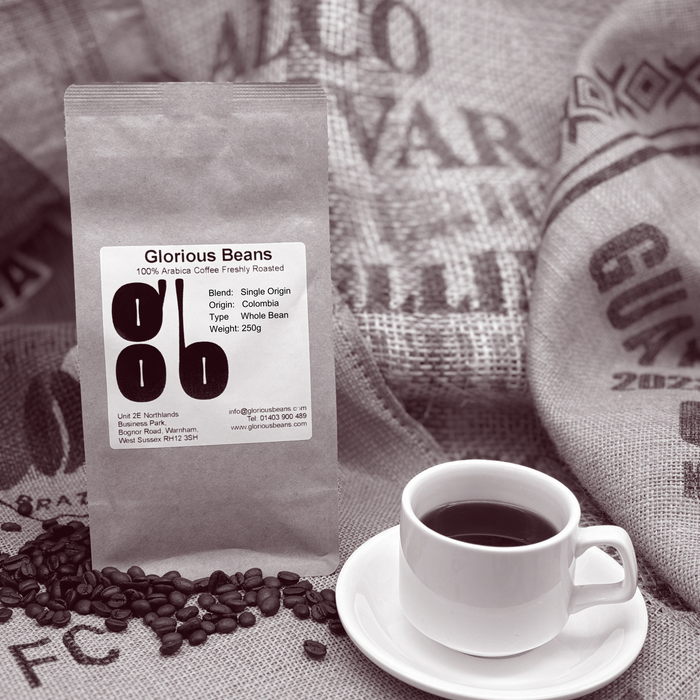Understanding Coffee Beans: the Trip From Coffee to Blended Coffee Beans

The Beginnings of Coffee: An International Point Of View
While you might believe of coffee as a modern staple, its origins map back centuries, linking with cultures across the globe. The tale starts in Ethiopia, where legend states a goat herder named Kaldi uncovered the energizing impacts of coffee beans after seeing his goats romping vigorously after consuming them.
As trade paths increased, coffee made its way to Europe in the 17th century, rapidly getting appeal. Each society added its distinct spin to coffee prep work, improving its history.
Cultivation and Harvesting of Coffee Beans
As coffee's trip advanced, the focus shifted to the cultivation and harvesting of particular bean varieties, especially those utilized for espresso. You'll discover that espresso beans commonly originate from Arabica or Robusta plants, each offering unique flavors. The suitable expanding problems include high altitudes and abundant, well-drained dirt, which improve the beans' quality.
During the harvest, choosing methods differ. In some areas, employees hand-pick ripe cherries, making certain just the finest fruit goes to handling. In other areas, mechanical farmers are utilized, especially on larger ranches. Timing is important; you wish to collect when the cherries get to peak ripeness for maximum taste.
As soon as collected, the beans are gotten ready for processing, which is essential in establishing their last taste. Understanding the farming and gathering procedures provides you insight into what enters into your preferred coffee, enriching your gratitude for each mug.
Processing Techniques: From Cherry to Bean
Since you've learnt more about gathering coffee beans, let's discover just how those cherries change into the coffee beans you enjoy. You'll see how different harvesting strategies effect flavor, complied with by the important actions of fermentation and drying out. Lastly, we'll break down the milling and grading process that establishes your coffee's high quality.
Gathering Strategies Discussed
When it comes to coffee, understanding harvesting techniques is vital, because they directly impact the taste and quality of the beans you enjoy. Selective picking entails hand-picking just ripe cherries, guaranteeing you get the finest high quality beans. Eventually, the choice of collecting technique can substantially affect your coffee experience, so it's worth recognizing just how those beans made it to your mug.
Fermentation and Drying Out
After gathering, the next steps in processing coffee beans play a significant duty in forming their flavor. You'll find that fermentation is vital, as it aids break down the mucilage surrounding the beans, enhancing their taste profile. Depending on the approach, this process can last from a couple of hours to numerous days, with varying results based upon temperature and humidity.
Once fermentation is complete, drying out complies with, which is equally important. You can pick from sun-drying or mechanical drying approaches. Sun-drying enables the beans to absorb tastes from the atmosphere, while mechanical drying out guarantees regular wetness levels despite weather. Appropriate drying out is important to protect against mold and maintain the beans' high quality, inevitably affecting your cup of coffee.
Milling and Grading Process
As fermentation and drying out set the phase for flavor growth, the milling and grading process assurances that just the finest coffee beans make it to your cup. This phase involves eliminating the external layers of the coffee cherry, consisting of the parchment and husk. After milling, the beans are sorted by dimension and weight, guaranteeing a consistent quality. You'll discover that grading helps determine issues and categorize beans, which affects flavor and aroma. Top quality beans get a greater quality, resulting in a richer coffee experience. When rated, the beans await product packaging and delivery, preserving their distinct attributes. This careful process is crucial for providing the remarkable taste you enjoy in every sip of your preferred brew.
Roasting Techniques: Unlocking Flavor Potential
When you roast coffee beans, the method you choose can dramatically impact the taste account. Recognizing the partnership in between time, temperature level, and toasting strategies is crucial to exposing the capacity of your brew. Let's check out how these elements integrated to create the perfect cup.
Roasting Methods Described
While you may believe that all coffee toasting methods generate the exact same outcomes, the truth is that each strategy reveals one-of-a-kind taste potentials in the beans. You can choose in between methods like drum toasting, air roasting, or perhaps traditional frying pan roasting. Drum roasting utilizes a turning drum to uniformly disperse warmth, boosting caramelization and producing a well balanced taste. Air roasting, on the various other hand, flows warm air around the beans, promoting a lighter roast with pronounced acidity. Frying pan roasting enables hands-on control however requires constant interest to avoid burning. Each approach has its nuances, so experimenting with various methods can help you uncover the ideal roast that straightens with your taste preferences. Enjoy the trip of finding your excellent cup!

Impact on Taste Account
Different roasting approaches not only influence the process however also considerably influence the flavor account of the coffee beans. When you pick a light roast, you'll experience bright acidity and flower notes, showcasing the bean's beginning. On the other hand, a medium roast balances acidity with sweet taste, frequently exposing chocolatey touches. Dark roasts, on the various other hand, highlight bold, smoky flavors, occasionally masking the bean's distinct characteristics. Each method discloses various oils and substances, leading to a vast array of flavors. By try out different roasting styles, you can find which profiles resonate with your palate. Understanding these nuances helps you appreciate the creativity behind your mug of coffee, enhancing your overall experience with every sip.
Time and Temperature Level Aspects
To release the full taste capacity of coffee beans, both time and temperature throughout the toasting process play considerable duties. When toasting, you'll locate that higher temperatures can quickly create tastes, however if you rush it, you might finish up with charred notes. Conversely, reduced temperatures enable for a more steady flavor development, showcasing the beans' one-of-a-kind features.

Timing is equally as essential; extending the roast as well long can lead to a loss of level of acidity and brightness, while also short a roast might leave the beans underdeveloped. Discovering that sweet area needs practice and trial and error. By adjusting these variables, you can reveal the abundant, complex tastes hidden within each bean, producing a genuinely remarkable coffee experience.
The Art of Mixing: Crafting Unique Coffee Accounts

Beginning by selecting a base coffee that offers a solid foundation. Select corresponding beans to boost details flavor notes. For example, a bright Ethiopian bean can bring fruitiness, while a rich Brazilian coffee adds body. Trial and error is vital-- do not hesitate to adjust ratios until you find your suitable account.
As you mix, remember that each mix informs a tale. You're not just making coffee; you're creating additional reading an experience. Take your time, taste frequently, and appreciate the trip of uncovering your trademark mix - Single Origin Espresso.
Developing Techniques: Exactly How Preparation Affects Flavor
Blending coffee opens up a domain name of taste possibilities, but just how you brew that blend can considerably affect your last cup. Different developing techniques draw out distinct flavors and fragrances, so it's critical to select carefully. A French press permits debris and oils to stay, producing an abundant, robust experience. On the various other hand, a pour-over highlights the coffee's quality and brightness, ideal for showcasing delicate notes.
Coffee, with its high pressure, generates a concentrated shot that emphasizes sweet taste and crema. If you like a lighter brew, think about a cold mixture method; it generates a smooth, much less acidic preference.
Ultimately, trial and error is crucial. Adjusting variables like water temperature, grind dimension, and make time can transform your coffee's account. So, accept the art of developing to uncover the tastes concealed in your coffee blends. The right method can raise your experience to new elevations.
The Future of Coffee: Sustainability and Technology
As the coffee industry evolves, sustainability and innovation are ending up being important for dealing with environmental difficulties and meeting customer demands. You'll discover that even more coffee companies are taking on eco-friendly methods, from sourcing beans fairly to applying lasting farming techniques. These shifts not only assist the world however additionally boost the quality of the coffee you delight in.
You could see developments like naturally degradable product packaging and water-saving developing techniques that lower waste. Advanced technology, such as blockchain, is likewise coming to be preferred, making certain openness in the supply chain, which permits you to map your coffee back to its beginnings.
Additionally, investing in local communities and supporting farmers through reasonable profession initiatives promotes a much more lasting coffee environment. As you drink your next cup, keep in mind that your choices can contribute to a see this brighter future for coffee. By selecting sustainable brand names, you're not simply enjoying a drink; you're making a favorable effect on the world.
Regularly Asked Inquiries
What Is the Distinction Between Arabica and Robusta Beans?
Arabica beans are smoother, sweeter, and have a greater acidity, while robusta beans are stronger, a lot more bitter, and include more high levels of caffeine. When making your coffee., you'll discover these differences in flavor and aroma.
How Does Elevation Affect Coffee Bean Taste?
Altitude influences coffee bean flavor substantially. Greater elevations create beans with brighter acidity and facility flavors, while reduced altitudes commonly generate beans that are heavier and much less nuanced. You'll notice these distinctions in your mug!
What Are the Health And Wellness Perks of Alcohol Consumption Coffee?
Consuming coffee can boost your power, boost mental emphasis, and even improve physical performance. It's abundant in antioxidants, might lower the danger of particular diseases, and can advertise a healthier metabolic rate when consumed in small amounts.
Can Coffee Beans Be Recycled for Brewing?
Yes, you can reuse coffee beans for developing, but the taste could be weak. If you enjoy exploring, attempt recycling them in different means, like cold mixtures or including in shakes for an added kick.
How Should I Store Coffee Beans for Quality?
To maintain your coffee beans fresh, keep them in an impermeable container in an amazing, dark area. Stay clear of subjecting them to wetness, light, or warm, as these aspects can promptly degrade their flavor and scent.
Recognizing Coffee Beans: the Journey From Espresso to Blended Coffee Beans.
Now that you've learned about harvesting coffee beans, allow's discover just how those cherries change right into the coffee beans you like.When you roast coffee beans, the technique you select can dramatically impact the flavor profile - Single Origin Espresso.While you might think that all coffee roasting methods generate the exact same results, the truth is that each technique reveals unique taste potentials in the beans.Different roasting approaches not just affect the process but also greatly impact the flavor profile of the coffee beans
Comments on “SOE Single Origin Espresso – Recommended for Precision Brewing Methods”